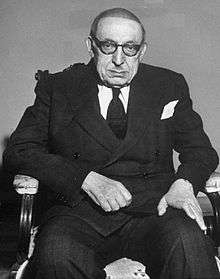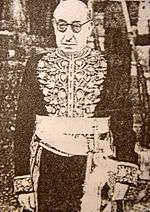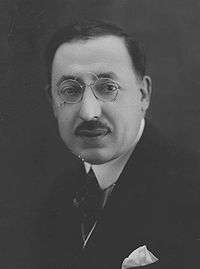Ahmad Qavam
| Ahmad Qavam | |
|---|---|
 | |
| Prime Minister of Iran | |
|
In office 17 July 1952 – 22 July 1952 | |
| Monarch | Mohammad Reza Pahlavi |
| Preceded by | Mohammed Mosaddeq |
| Succeeded by | Mohammed Mosaddeq |
|
In office 28 January 1946 – 18 December 1947 | |
| Monarch | Mohammad Reza Pahlavi |
| Preceded by | Ebrahim Hakimi |
| Succeeded by | Mohammad-Reza Hekmat |
|
In office 9 August 1942 – 15 February 1943 | |
| Monarch | Mohammad Reza Pahlavi |
| Preceded by | Ali Soheili |
| Succeeded by | Ali Soheili |
|
In office 22 June 1922 – 15 February 1923 | |
| Monarch | Ahmad Shah Qajar |
| Preceded by | Hassan Pirnia |
| Succeeded by | Mostowfi ol-Mamalek |
|
In office 4 June 1921 – 21 January 1922 | |
| Monarch | Ahmad Shah Qajar |
| Preceded by | Zia'eddin Tabatabaee |
| Succeeded by | Hassan Pirnia |
| Personal details | |
| Born |
2 January 1876 Tehran, Iran |
| Died |
23 July 1955 (aged 79) Tehran, Iran |
| Political party | Democratic Party |
| Religion | Islam |
Ahmad Qavām (2 January 1876 – 23 July 1955) (Persian: احمد قوام), also known as Qavām os-Saltaneh (Persian: قوام السلطنه), was a politician who served as Prime Minister of Iran five times.
Early life
Qavam was born in 1876 to a prominent Iranian family. His uncle, Amin Aldoleh, was a prime minister of Iran. He served in the royal court of Nasereddin Shah early in his career. He slowly climbed his way up, and obtained the title Ghavam al-Saltaneh during the Constitutional Revolution of Iran. Hasan Vothuq (also known as Vothuq al-Dowleh) was his older brother. The letter signed by Mozaffaredin Shah to accept the Iranian Constitutional Revolution was written by Qavam, who had the title of Dabir-e Hozoor (Private Secretary) at the time. In fact Qavam was instrumental in the Iranian Constitutional Revolution[2]. He became Prime Minister several times during both Qajar and Pahlavi dynasties. Any time the country needed him, he accepted the challenge. He played a significant role in preventing the USSR from separating Iran's northern states twice [2]. Nevertheless, historians have mixed feelings about his legacy.
Political career

In 1921, during the coup d'état of Tehran against the Qajar government, Tabatabaei ordered Colonel Pesian to arrest many of the opposition, among them Ahmad Ghavam. Ghavam was arrested and sent to Tehran.
However with the fall of Zia'eddin Tabatabaee's government, Mostowfi ol-Mamalek among others was offered the position of Prime Minister, which he and the rest declined, due to the unstable political situation at the time. Hence Ghavam who had just been released from the Ishratabad prison of Tehran was offered the position, which he accepted and became Prime Minister overnight. So unusual was his rise that Iraj Mirza wrote the following verses:
یکی را افکند امروز در بند
کند روز دیگر او را خداوند
"One day in prison he is thrown,
another day the King's chair he'll own"
Ghavam in fact ordered the arrest of Seyyed Zia'eddin Tabatabaee in an incident 25 years later. He also ordered the crackdown on the revolt of Colonel Pesian which he crushed with the aid of Reza Pahlavi
Of the major events that occurred during his terms as the Prime Minister, was his invitation to Arthur Millspaugh for assisting the government in its finances. Another was the riots of 1942 for economic hardship. He appointed Sepahbod Ahmad Amir-Ahmadi to restore order and end the riots, which he did forcefully. Qavam was also instrumental in the 1919 treaty between Iran, Russia, and Britain.

He was again voted Prime Minister on 26 January 1946 with a slim margin in the Majlis of 52-51.[1] The Majlis thought he would have the best chance of resolving the Soviet inspired rebellion of the occupied Azerbaijan province since Qavam was the largest property-owner in the region. Qavam did not disappoint. He ordered the Iranian delegation to the UN to negotiate issues pending before the Security Council directly with the Soviet delegation. He then flew to Moscow to discuss the issues personally with Stalin.[2]
When the Soviets violated the terms of the Tripartate Pact which called for all foreign military forces to be withdrawn from Iranian territory by 2 March 1946, it drew a strong rebuke from Parliamentary Whip, Mohammed Mossadegh.
Qavam arranged a deal with the Soviets, granting an oil concession in the North contingent on the approval of the Majlis after the elections. Under the terms of the agreement with Qavam, Soviet troops began withdrawing from Iran. When the new Majlis was seated, they immediately voted against the proposed Soviet oil concession.[3] This earned Qavam the congenial title, "The Old Fox".
Death
Qavam died at the age of 79 in 1955 in Tehran. He was survived by his second wife and his only son, Hossein.
See also
- Pahlavi Dynasty
- List of Prime Ministers of Iran
- Reza Shah
- Mohammad Reza Shah
- Abdolhossein Teymourtash
- Ali Akbar Davar
- Mirza Javad Khan Ameri
References
- ↑ "Iran Chooses Premier in 51 to 50 Vote", Salt Lake Tribune, 27 January 1946, p8; Manuucher Farmānfarmaian and Roxane Farmanfarmaian, Blood and Oil: A Prince's Memoir of Iran, from the Shah to the Ayatollah (Random House, 2005), p. 179
- ↑ Samii, Bill (6 May 2005). "World War II -- 60 Years After: The Anglo-Soviet Invasion Of Iran And Washington-Tehran Relations". Radio Free Europe. Retrieved 11 November 2012.
- ↑ Rubin, Barry (1980). Paved With Good Intentions. Oxford University Press. pp. 33–35. ISBN 0-19-502805-8.
- The following reference was used for the above writing: 'Alí Rizā Awsatí (عليرضا اوسطى), Iran in the Past Three Centuries (Irān dar Se Qarn-e Goz̲ashteh - ايران در سه قرن گذشته), Volumes 1 and 2 (Paktāb Publishing - انتشارات پاکتاب, Tehran, Iran, 2003). ISBN 964-93406-6-1 (Vol. 1), ISBN 964-93406-5-3 (Vol. 2).
- A book in Persian called Dar Tir Rase Hadese, The political life of Qavam osSaltaneh. First published in Tehran, winter of 2006. Author: Hamid Shokat, ISBN 9789648897142. Published by akhtaranbook (www.akhtaranbook.com)
Sources
External links
| Wikimedia Commons has media related to Ahmad Qavam. |
| Political offices | ||
|---|---|---|
| Preceded by Zia'eddin Tabatabaee |
Prime Minister of Iran 1921-1922 |
Succeeded by Hassan Pirnia |
| Preceded by Hassan Pirnia |
Prime Minister of Iran 1922-1923 |
Succeeded by Mostowfi ol-Mamalek |
| Preceded by Ali Soheili |
Prime Minister of Iran 1942-1943 |
Succeeded by Ali Soheili |
| Preceded by Ebrahim Hakimi |
Prime Minister of Iran 1946-1947 |
Succeeded by Mohammad-Reza Hekmat |
| Preceded by Mohammad Mossadegh |
Prime Minister of Iran 1952 |
Succeeded by Mohammad Mossadegh |
| Party political offices | ||
| Preceded by None |
Leader of Democratic Party 1918-1949 |
Succeeded by Ali Amini |